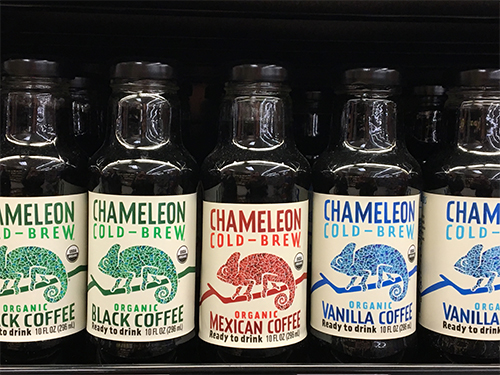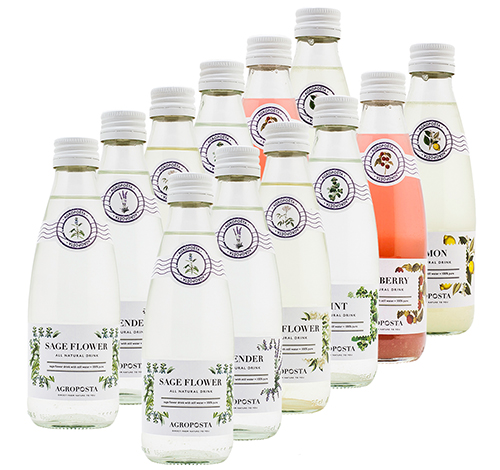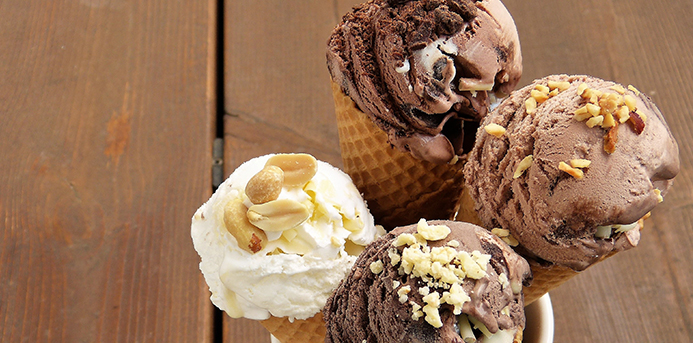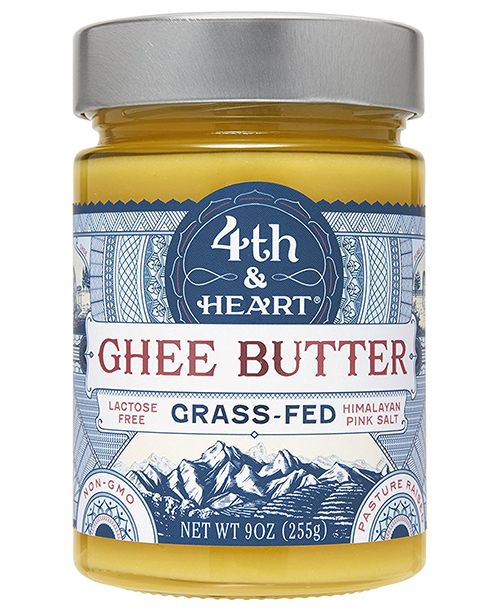On New Year’s Day, most people make a list of the fattening foods they plan to avoid, the diet they plan to start, or the healthy comestibles they will start ingesting posthaste in an effort to start the New Year right. Me? I’m combing the internet, magazines, and other information oracles in order to make my own list: the foods that everyone will be eating this year — what I predict will be ubiquitous in restaurants, groceries, and specialty food stores. Here’s what I’ve gleaned from my research, and I’m sharing it with MIB readers so that you can be on that bandwagon from the get-go.
Global Ice Cream
Ice cream is a perennial favorite, but the proliferation of Instagrammable Asian ice cream and shaved ice concoctions (Thai rolled ice cream, Filipino halo halo, Japanese mochi), Latin favorites (paletas, churros sundaes, Mexican helado frito, Argentine gelato) and previously unexplored ice cream flavors (Vietnamese coffee, goat cheese, beet, corn, avocado, Chai tea, purple yam, basil) has raised the game to a new level. In the Chicago area, check out Legend Tasty House for trendy Thai treats; La Michocana Premium for Latin flavors and paletas; Evanston’s Frio Gelato for allergen-friendly Argentine gelatos (dulce de leche and avocado are popular flavors); and one of the Jeni’s Splendid Ice Cream locations for inspired combos like Sweet Potato with Torched Marshmallows or Goat Cheese with Red Cherries.
Roasted/Grilled Fruit
Roasted veggies are ubiquitous on menus from coast to coast. But here’s something hip pastry chefs know that you might not: Roasting or grilling fruit concentrates flavor and caramelizes natural sugars. It can render so-so fruit delicious, ripe farmers market fruit stupendous. The process has been popping up in some of my favorite new cookbooks and on menus around the country. One of the best things I ate this year was a Roasted Blueberry and Buttermilk Milk Shake at Duckfat in Portland, Maine. The intense hit of blueberry made me feel a little like Violet Beauregarde of Willy Wonka fame, but the natural sweetness was nicely offset by the buttermilk’s acidity. Look for roasted fruit in of-the-moment libations and pureed into ice creams; poured over cake or French toast; tossed in salads; scattered on top of pizzas; or served with pork or poultry.
New Year’s Bonus Tip: Here’s a recipe for Stella Parks’ delicious Roasted Cherry Ice Cream.
Activated Charcoal
Once limited to ERs for treatment in poisonings and drug overdoses, activated charcoal has been discovered by the food industry for the same properties, but on a much smaller scale. A byproduct of burning coconut shells or other plant materials, the negative charge of activated charcoal binds to positively charged ions and helps remove them from your digestive system — a mini detox of sorts. It’s being touted as a hangover cure and showing up in products from fresh-pressed juices and smoothies to ice cream. If you can get past the black or deep gray hue of the food or drink you’re consuming, there may be some benefits. However, according to Raeanne Sarazen, a registered dietitian nutritionist, not all these claims are supported by science, and the makers of supplements — like activated charcoal — don’t have to show their products safe or effective before selling them. Nonetheless, I love it in Vosges’ Super Dark Chocolate with Coconut Ash and Banana, rich in antioxidants and vitamins. Pressed Juicery makes an Activated Charcoal Lemonade that’s all the rage, and Dr. Oz recently featured an Activated Charcoal Smoothie on his website.
Pour-Over and Enriched Coffee
High-end coffee continues to be a story, and we want access to great coffee wherever we are. For purists, it’s all about the European pour-over method. “It produces that purest flavored coffee, as all you’re really tasting is the coffee and the essential oils that come from the roasted beans themselves,” says Julie Gordon of Inspiring Kitchen. “This is the best way to do it; there is even a single-cup portable system that works great when you’re traveling and want good coffee.” New Year’s Bonus Tip: Check out the Coffee Gator Pour-Over Coffee Maker with thermal vacuum cup and micromesh filter, perfect for travel. Enriched coffees are making real inroads. Bulletproof coffee, also known as “keto coffee,” sees the addition of grass-fed butter and coconut oil to your morning cuppa joe, preferably made in a French press or Turkish coffee pot. You then blend in the butter and coconut oil to evenly disperse the fat throughout the coffee. This concoction is purported to stimulate your metabolism and boost brain function.

Nitro cold-brew coffee is everywhere, both on-tap at restaurants and coffee specialists, and in cans and bottles at most grocery stores. The coffee is infused with nitrogen gas and dispensed through a pressurized drafting system, which creates a smooth pour with a creamy head, like a good stout. Look for Stumptown, La Colombe, or Chameleon, all solid brands and perfect as the base of a great iced coffee. I also like Califia, which makes a terrific cold brew with almond milk.
Floral Notes
If you’re a fan of the “Great British Baking Show” — and if you aren’t, later with you — you already know that overdoing floral essences like rose and violet can quickly turn an otherwise scrumptious dessert into a soapy-tasting flop, and no one wants that! But just the right amount of floral notes in a cocktail, creamy dessert, or baked good can be delightful; a judicious hand is all it takes. Celebrated food blogger Molly Yeh is a fan of flower flavors, which you’ll find as a focal point in her Orange Blossom Almond Cake or Coconut Rose Cake. On restaurant menus, you’ll find that hibiscus turns up in everything from cocktails (like The Violet Hour’s Troublemaker, with La Favorite Blan Rum, lime, and spiced hibiscus liqueur) to desserts (Lena Brava’s Apple-Piloncillo Upside-Down Cake is garnished with candied hibiscus flowers; Chilam Balam’s Hibiscus Flan with vanilla-swirl ice cream and candied pumpkin seeds), and even a taco at Takito Kitchen, where a hibiscus tortilla stuffed with coconut custard and cabbage slaw cradles crispy chunks of fish. 
The floral drink trend continues on the home front with new botanical imports like Agroposta’s all-natural still-water drinks, flavored with sage flower, lavender, or elderflower, lovely mixed with gin or lemonade over ice, or the veddy British Fentimans Rose Lemonade, also fabulous with a little gin or vodka, but then again, what isn’t?
Ghee
Once found largely in Indian restaurants and homes, where it was valued for its high smoke point and keeping qualities, ghee is breaking big as a Paleo- and Whole 30-friendly ingredient. It is made by simmering and clarifying butter of all its milk solids; the liquid fat remaining is the ghee, which solidifies at room temperature. Artisanal ghee made from grass-fed butter is the current chef’s darling, and you can find jars of it at most grocery and specialty food stores, as well as on Amazon.
Middle Eastern Cuisine
From food trucks to fine dining, Middle Eastern cuisine continues on the rise. Where it used to conjure images of falafel, hummus, and pita bread, Yotam Ottolenghi’s London restaurants and best-selling cookbooks seemed to light a fire of creativity and inspire Israeli-born chefs like Michael Solomonov (the 2017 James Beard Award Outstanding Chef for Zahav in Philadelphia) and Alon Shaya (another James Beard Award winner for Shaya in New Orleans, now the subject of a custody battle of sorts) to open stateside restaurants revolving around their native cuisine. In Chicago, Lettuce Entertain You has had great success with River North’s Ema, where chef CJ Jacobson’s Lamb and Beef Kefta Kebabs are drizzled with lemon, olive oil, and tzatziki; the Hummus is topped with braised lamb ragu and spicy harissa sauce; and Halva, a Middle Eastern confection made of pureed sesame seeds and sugar, is garnished with medjool dates and candied nuts. Wines from Israel, Morocco, and Lebanon are featured on their list. Noon O Kabab, a “perfectly Persian” restaurant in the North Center neighborhood, takes a deeper dive into Middle Eastern food than most, with dishes like Aash-E-Reshteh, a vegetarian stew made with spinach, cilantro, oats, lentils, beans, chick peas, and noodles, or Fessenjan, chicken simmered in pomegranate-walnut sauce. Looking to Ottolenghify your home kitchen? Stop in to Pita Inn Market & Bakery in Skokie, where you’ll find everything from dried legumes and grains to halal meats, dairy, and seemingly every type of pickled vegetable or olive in existence. Look for fresh house-made pita and lavash breads, as well as rich baklava and kinafa, a traditional cheese pastry topped with shredded filo (kataifi). And of course, rosewater figures heavily in Middle Eastern sweets, so you can tick off two 2018 food trends in one visit!

Julie Chernoff, Make It Better’s dining editor since its inception in 2007, graduated from Yale University with a degree in English — which she speaks fluently — and added a professional chef’s degree from the California Culinary Academy. She has worked for Boz Scaggs, Rick Bayless and Wolfgang Puck (not all at the same time); and sits on the boards of Les Dames d’Escoffier International and Northlight Theatre. She and husband Josh are empty nesters since adult kids Adam and Leah have flown the coop. Rosie the Cockapoo relishes the extra attention.


